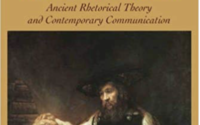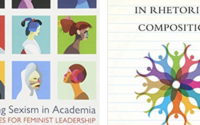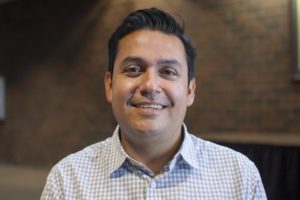The Place of Free Speech: Making Controversy Material at the Neoliberal University
On the morning of May 2, 2017, a group of students at California State University, Fresno, took chalk and began writing antiabortion statements near the campus library entrance. The statements were pro-life: “You CAN be pregnant & successful”; “Unborn lives matter”; and “Women need love, NOT abortion.” A professor at the University, Gregory Thatcher, came upon the statements and attempted to erase them with his shoe. When the pro-life students confronted the professor, Thatcher asked if they had permission to write the statements. He admonished the students: they ought to have put the statements in the nearby “Free Speech Area.” Thatcher allegedly told the students, “You had permission to put them down; I have permission to remove them.” After this initial confrontation, Thatcher returned with some of his students and put down pro-choice statements in the same area, including, “My body, my choice”; “Your body, your choice”; and “I [heart] you.”
The focus of this essay is the Free Speech Area on the campus of California State University, Fresno (also known as Fresno State)—how its existence evinces one outcome of the increasing neoliberalization of US public universities. I argue that Fresno State is able to concretize the abstract value of free speech through this space in ways that allow it to manage the rhetorical work of students, faculty, employees, and visitors so as to order it along market logics. Even as the space has caused confusion regarding precisely where on campus one may practice free speech (answer: everywhere), the university continues to defend its existence even when it is weaponized against others. In arguing that neoliberalization remakes public space in contradictory ways, this study aligns with and contributes to the rhetorical study of institutions and of the production of space.
Central to this argument is the work of Roxanne Mountford and Richard Marback, rhetorical scholars whose works demonstrate how to engage space rhetorically. Mountford forwarded the notion that “rhetorical space is the geography of a communicative event,” highlighting the importance of space in any situation in which agents are communicating purposefully (42). For his part, Marback tells us that rhetorical space is dynamic. Looking to Robben Island to explicate this claim, Marback notes how the island extends beyond its physical geography, serving as a source for the social imaginary of South Africans. Marback’s examination shows how Robben Island is “a location enforcing colonialist hierarchies and enabling opposition to those hierarchies” (13). Universities in the US are especially ripe for the type of analyses and critiques modeled and encouraged by Mountford and Marback. For one, the space comprising universities does “not exist in some abstract academic place,” notes la paperson; “they are built on land, and especially in the North American context, upon occupied Indigenous lands” (25-26). There is indeed a particular materiality to university campuses, a materiality steeped in histories of colonialism, dispossession, and oppression (see Wilder 2014). As public universities remake themselves within a larger project of neoliberalization, these histories are reanimated in ways that complicate or run counter to the stated missions of public universities.
Mountford’s work has allowed rhetorical scholars to recognize that space is often “a physical representation of relationships and ideas” (42). This is evident in Marback’s analysis of how Robben Island both emplaces colonial hierarchies and provides an opening to oppose them. Scholars following and building on Mountford and Marback apply this insight to space and public memory, political organizing, consumerism, civic engagement, and more (see Dickinson, Blair, Ott, Michel, Topenka, Rice, or Fleming). I bring this scholarship to bear on an examination of the Free Speech Area on the Fresno State campus, and on the interaction between Thatcher and the pro-life students in particular, to argue that the neoliberal public university is newly able to mobilize public space toward controversy and for its own self-interest—and not necessarily for the sake of the public good.
Entering the Free Speech Area
The Free Speech Area on the Fresno State campus emerges at the end of a heavily trafficked corridor running through the middle of campus. Students, faculty, and staff are funneled into the space existing between the Student Union and the University Center. This is where the Free Speech Area begins. Even though the Free Speech Area is not actually bordered in any way, it is commonly understood that the Free Speech Area exists between this passage, the library entrance, and the edge of the Peace and Native Plants Gardens. The focal point of the space is a brick platform at the edge of these gardens (see Figure 1).

Aside from student groups and organizations, the Free Speech Area is also host to a number of outside groups, including candidates for public office, religious proselytizers, recruiters, etc. On most occasions, the communicative action that takes place in the Free Speech Area seems mostly passive: people and groups set up tables and wait to be approached (see Figures 2 and 3). The Peace Garden, in its commemoration and memorialization of civil rights leaders, lends an even greater import to the adjacent area because it relates the actions that take place nearby to the rhetorical actions of Martin Luther King, Jr., Cesar Chávez, Jane Adams, and Mohandas Gandhi. Together with the Native Plants Garden, which houses plants used by the indigenous people of the region, these ambiguously demarcated spaces inter-amplify their symbolic functions. As a complex, they relate civil rights, social justice, and free speech. All three say something about the University: that it values these ideals so much that it allots physical space to them. And, yet, this image isn’t always consistent with how the Free Space Area operates in practice. At various times, the Free Speech Area has provoked controversy, causing students to call for a name change.
The idea that free speech is allowed anywhere on campus is a point that has needed to be made over and over in relation to this space at Fresno State. While this is likely true at other public universities, the Free Speech Area on this campus has itself been a source of confusion. Why the University insists on maintaining a specific place on campus named after “free speech” that creates confusion about where free speech is possible and that can be activated against others’ free expression says a lot about what a university values and/or about the value it extracts from political difference and debate.
What’s in a Name: The Value of Controversy
In October 2015, a student-led effort called upon University administrators to change the name of the Free Speech Area. Josh Erdington, the Student Involvement Club and Organization Coordinator at the time, was a vocal proponent of the change because he felt that calling one single place on campus the “Free Speech Area” causes some to think this is the only place one can exercise this right. In statements made to The Collegian, Erdington explained: “In a sense, it almost seems like we are containing free speech to one centralized area on campus. In a public institution, free speech is anywhere as long as it’s not disrupting the academic mission of the university” (Kassahun).
That October, Fresno State ’s Associated Students, Inc. (ASI), surveyed the student body to gauge interest for renaming the Free Speech Area.1 The survey stated that the reason ASI was considering a name change was because “this area is currently referred to as the Free Speech Area, which implies freedom of expression is confined to this area” (Bronson). Later that month, ASI announced that it was indeed moving forward with plans to rename the space to “Union Square” (Kassahun).
The Collegian confirmed the change in name in March 2015 in a story titled, “Free Speech Area Renamed.” Whether the headline was premature, or the decision reversed over summer, The Collegian ran a correction in November under the headline: “FREE SPEECH AREA NOT TO BE RENAMED.” In what appears to be a statement from the administration (the entire piece is four paragraphs long and placed within quotation marks, suggesting it was published verbatim), Vice President for Student Affairs and Student Management Frank Lamas defended the name in saying, “the Free Speech Area has been the campus’ most visible space for students, faculty, staff and community members to openly express ideas and points of view” (Lamas).
This defense of the name (and of the potential overriding of a student government decision) indicates that the University found greater value in retaining the name than in changing it. Given that the name change to “Union Square” was motivated by a desire to promote the idea that free speech is possible anywhere on campus, it would seem that the University administration placed greater value in whatever the space was doing in its current iteration than in clearing up confusion. This value, I argue, is drawn from what a university is newly able to do under neoliberalization with the differences and debates that otherwise characterize the intellectual life of a university.
The neoliberal university can extract more value from difference and debate when it is able to make these visible and controversial. Therein lies the value of public space for the neoliberal university. For the neoliberal university, it is more valuable that a debate happens openly and publicly; it’s not enough that ideas get debated in classrooms. Open controversy, the type that happens out in the open—in reference to a space named for “free speech”—is of more value to a university because it can leverage public controversy into asks and a reputation.
I draw here from an articulation of neoliberalism that is defined as “the reassertion of a classical liberal economic argument: society functions better under a market logic than any other logic, especially a state-directed one” (Purcell 141). Fresno State’s insistence on retaining this space and its name echoes Rob Asen’s claim that, under neoliberalism, groups and institutions do not aim toward a common good but engage as self-interested agents (331). While free speech is typically construed as necessary to the “common good,” here the university has found a way to repackage and ship difference for its own self-interest by making it visible—a brand of sorts. It is not enough that differences in ideology and politics already exist at this university—and that these are already being espoused and debated in meaningful and productive ways through the intellectual work of the university—no: the normative intellectual activity of the university is not in itself profitable under market logics, not when it is contained to instructional spaces. This activity needs to be brought out and made public—rendered controversial—so that the university can benefit from it more directly. The neoliberal public university is neosophistic in this regard: the merits of an argument are not where value lies for the university; rather, value lies in how public and visible the debate—any debate—could be.
The ways public space is remade to serve the interests of the University has necessarily impacted the quality and nature of the arguments people have at Fresno State. Take the incident between Thatcher and the pro-life students. When Thatcher first confronts them, the students don’t appeal to their right to free expression as it exists; rather, they reference the permission they sought and got from the university to put down the pro-life statements. Thatcher, likewise, doesn’t engage the students on the basis of the arguments they are making through the statements; instead, he admonishes them for not having put them down in the Free Speech Area: “The whole idea of free speech is that we have a free speech area on campus, ‘kay?”2 Thatcher is not right in saying that the “idea of free speech” is only possible in the Free Speech Area, but he is right when he recognizes that there is a reason for the Free Speech Area to exist at all: this is where the University would prefer people to express their opinions. That preference, it would seem, has all to do with how the neoliberal university is able to turn public debates like this one into controversies it can then cast as commitments to free speech in general, or to whatever aspects of the debate resonate with potential donors or future students.
Even as the argument between Thatcher and the students hinges on the students not expressing themselves in the space preferred by the University—even as it happened outside the Free Speech Area—the space is what anchors the controversy. In this regard, the space is functioning as it should. Thatcher claims authority for his actions from the existence of the Free Speech Area. Thatcher also negates the students’ free speech rights in reference to the space. Ultimately, Thatcher’s authority and ability to mount an argument and to thwart others’ free speech stems from the space, which is an extension of the University. Thatcher may well be making the arguments, but it’s the existence of the Free Speech Area—the space itself—that authorizes these arguments. In this way, the University bears ultimate responsibility for the confusion and the contradictions resulting from the existence of the space.
The space of free speech on the Fresno State campus is not a passive backdrop made meaningful only through subjective use. As Kevin Hetherington notes, places like this one are useful for “establishing a system of differences that requires an ordering” (187). It is not as if the Free Speech Area at Fresno State itself promotes differences in thought; it is that it makes these differences visible and makes them available to the University in a way that instruction and scholarly publication does not. In his statement, Lamas identifies the value of the space when he describes it as “the most visible space for students, faculty, staff and community members to openly express ideas and points of view” (Lamas). Visibility is what is most valuable in this calculus: it is important not only that people see the space but also that the space makes visible the intellectual differences within the University.
Rhetorical production over ideological difference that is not highly visible or controversial does not give the University opportunities to reassert its supposed commitment to free speech. The University requires that debates about free speech happen semi-regularly so that it can take a visible position that it can the use to appeal to donors and other monetary sources. This is why the Free Speech Area at Fresno State is so desirable to the administration. This is also why it is worth maintaining despite the confusion it causes. Its existence allows the University to order people’s differences in ways that serve its interests.
By anchoring his authority in the Free Speech Area, and, conversely, invalidating the student’s action through it as well, Thatcher participates in the University’s neoliberal project of ordering and packaging others’ rhetorical production for its own gain. This is a project that seeks to make visible the differences among faculty, staff, and students—in order to present itself as a scion of whatever values donors, politicians, and potential students favor. As a university that values free speech so much that it has given space over to the ideal—and that is willing to defend its existence even as it creates confusion about where on campus free speech is permissible—the University brands itself as an institution worthy of tuition and donation dollars. In an era of neoliberalization, Fresno State recognizes the value of the brand.
Conclusion
There are other factors at work in the exchange that took place between Thatcher and the pro-life students than the ones I have examined here. For one, the exchange is charged with issues of status—institutional, moral, gendered—and these certainly inform what each party could say and do in the exchange. But it would be a significant oversight to ignore the role that the materiality of space plays in the exchange. Looking at the space—how it is leveraged by Thatcher against the students and how the University has defended the space even as it can be used to shut down free speech—illuminates the ways neoliberalism has remade space in public universities. Under this ideology and system, individual entities can mobilize space and ideals meant for the public good toward their own interests. We should not assume or take for granted that the interests of the neoliberal university are correlated with the common interests of the community.
Acknowledgements
The author wishes to thank the editors and reviewers for their generous and useful comments during the review process, and Tom McNamara for productive feedback in the early stages of this project.
Notes
- Precisely when this area became the “Free Speech Area” is difficult to determine. Neither The Collegian’s archives nor the University’s archives contain specific documentation of when the idea of free speech became associated with the space. A conversation with a colleague who was an undergraduate student at Fresno State in the 1990s stated that, at that time, the space was already known, colloquially, as the Free Speech Area. return
- To see a video of the incident, go to https://youtu.be/Lz3MhiRj5HQ return
Works Cited
Asen, Robert. “Neoliberalism, the Public Sphere, and a Public Good.” Quarterly Journal of Speech, vol. 103, no. 4, 2017, pp. 329-49.
Blair, Carole. “Contemporary US Memorial Sites as Exemplars of Rhetoric’s Materiality.” Rhetorical Bodies, edited by Jack Selzer and Sharon Crowley, U of Wisconsin P, 1999.
Blair, Carole, and Neil Michel. “Reproducing Civil Rights Tactics: The Rhetorical Performances of the Civil Rights Memorial.” Rhetoric Society Quarterly, vol. 30, no. 2, 2000, pp. 31-55.
Dickinson, Greg, Carole Blair, and Brian L. Ott, editors. Places of Public Memory: The Rhetoric of Museums and Memorials. U of Alabama P, 2010.
Fleming, David. City of Rhetoric: Revitalizing the Public Sphere in Metropolitan America. SUNY, 2008.
Hetherington, Kevin. “In Place of Geometry: The Materiality of Place.” The Sociological Review, vol. 45, no. S1, 1997, pp. 183-99.
Kassahun, Tomas. “Free Speech Area Renamed.” The Collegian, 17 Mar. 2015, collegian.csufresno.edu/2015/03/17/free-speech-area-renamed/. Accessed 29 June 2017.
Lamas, Frank. “Free Speech Area Not to Be Renamed.” The Collegian, 1 Nov. 2015, collegian.csufresno.edu/2015/11/01/free-speech-area-not-to-be-renamed/. Accessed 29 June 2017.
Marback, Richard. “The Rhetorical Space of Robben Island.” Rhetoric Society Quarterly, vol. 34, no. 2, 2004, pp. 7-27.
Mays, Mackenzie. “In Argument over Free Speech, Fresno State Professor Rubs out Anti-Abortion Chalk Message.” Fresnobee.com, 11 May 2017, www.fresnobee.com/news/local/article150003172.html. Accessed 29 June 2017.
Mountford, Roxanne. “On Gender and Rhetorical Space.” Rhetoric Society Quarterly, vol. 31, no. 1, 2001, pp. 41-71.
paperson, la. A Third University Is Possible. U of Minnesota P, 2017.
Rice, Jenny. Distant Publics: Development Rhetoric and the Subject of Crisis. U of Pittsburgh P, 2012.
Topinka, Robert J. “Resisting the Fixity of Suburban Space: The Walker as Rhetorician.” Rhetoric Society Quarterly, vol. 42, no. 1, pp. 65-84, tandfonline.com/doi/abs/10.1080/02773945.2011.622342.
Students for Life. “Fresno State Students For Life—Confronted By Faculty and Wiping out Their Free Speech.” YouTube, 11 May 2017, www.youtube.com/watch?v=Lz3MhiRj5HQ&=&feature=youtu.be.
Wilder, Craig Steven. Ebony and Ivy: Race, Slavery, and the Troubled History of America’s Universities. Bloomsbury, 2014.
KEYWORDS:
COVER IMAGE CREDIT: Author






 Rubén Casas is an Assistant Professor of Interdisciplinary Arts at the University of Washington Tacoma.
Rubén Casas is an Assistant Professor of Interdisciplinary Arts at the University of Washington Tacoma.